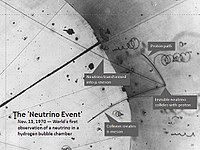
Photo from wikipedia
We present a detailed modeling and computation methodology to determine the optical Cherenkov signals produced by upward-moving extensive air showers (EASs) induced by $\ensuremath{\tau}$-leptons and muons, sourced from the interaction… Click to show full abstract
We present a detailed modeling and computation methodology to determine the optical Cherenkov signals produced by upward-moving extensive air showers (EASs) induced by $\ensuremath{\tau}$-leptons and muons, sourced from the interaction of high-energy astrophysical neutrinos interacting in the Earth. Following and extending the physics modeling and Cherenkov signal simulations performed in M. H. Reno et al. [Phys. Rev. D 100, 063010 (2019)], this scheme encompasses a new, state-of-the-art computation of the muon neutrino propagation inside the Earth and the contribution to the $\ensuremath{\tau}$-lepton muon decay channel. The modeling takes into account all possible $\ensuremath{\tau}$-lepton decay and muon energy loss channels that feed the optical Cherenkov emission, produced by both tau and muon initiated EASs. The EAS modeling uses the electron energy, angular, and lateral distributions in the EAS and their evolution as well as the wavelength dependence of the Cherenkov emission and its atmospheric attenuation. The results presented here are focused on the detection capabilities of suborbital (balloon-borne) and orbital (satellite) based instruments. The latter case was calculated for POEMMA [The Probe Of Extreme MultiMessenger Astrophysics] to compare to that presented in M. H. Reno et al. [Phys. Rev. D 100, 063010 (2019)], specifically including the muon-decay channel of $\ensuremath{\tau}$-leptons and the muonic EAS Cherenkov signal from muon neutrino interactions in the Earth. By detailing all these individual contributions to the optical Cherenkov emission and detection, we show how the ensemble that includes muonic channels provides a large detection capability for space-based, high-energy cosmic neutrino detection. Specifically, we show that for neutrino energies $\ensuremath{\lesssim}10\text{ }\text{ }\mathrm{PeV}$, the upward-EAS sensitivity due to muon neutrino interactions in the Earth begin to dominate over that for tau neutrino interactions, effectively extending the neutrino sensitivity to lower energies.
Journal Title: Physical Review D
Year Published: 2021
Link to full text (if available)
Share on Social Media: Sign Up to like & get
recommendations!